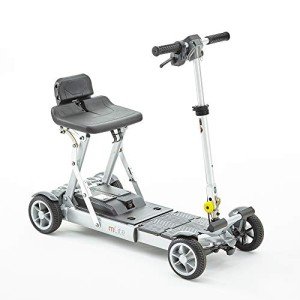What's The Reason? Mobility Devices Is Everywhere This Year
Understanding Mobility Devices: Enhancing Independence and Quality of Life
In today's fast-paced world, the desire for mobility is universal. However, certain medical conditions or age-related obstacles can hinder motion, resulting in a continuous search for help. Mobility devices serve as necessary tools to boost self-reliance, enhance lifestyle, and make it possible for individuals to engage completely in their neighborhoods. lightweight mobility scooters provides a detailed overview of mobility devices, including their types, functions, selection requirements, and more.
Kinds Of Mobility Devices
Mobility devices vary from easy aids to intricate equipment, tailored to meet numerous requirements. Below is a table summarizing typical types of mobility devices:
Type of Device
Description
Suitable For
Walkers
Four-legged assistance devices that offer remarkable stability while strolling.
People needing extra support.
Canes
Single or three-legged sticks that enhance balance and support walking.
Those with minor mobility troubles.
Wheelchairs
Seats installed on wheels, available in handbook and electric variations.
Individuals with minimal or no mobility.
Scooters
Electric vehicles designed for outdoor usage and ease of navigation.
Those who can't stroll fars away.
Crutches
Devices that assist individuals transfer weight far from a hurt leg.
People recuperating from leg injuries.
Rollators
Walkers with wheels, seats, and brakes for improved mobility.
Users requiring rest alternatives while walking.
Lift Chairs
Reclining chairs that assist users in standing and taking a seat.
Seniors or those with mobility constraints.
Mobility Scooters
Small electric vehicles for minimal mobility, often utilized outdoors.
People needing support over cross countries.
Key Features of Mobility Devices
When choosing a mobility device, several key features need to be considered to guarantee optimal performance and ease of use:
- Weight Capacity: Understanding the gadget's weight restriction is vital for safety and efficiency.
- Adjustability: Devices ought to be adjustable in height and width to fit the user conveniently.
- Portability: Lightweight and foldable options are necessary for users who travel or require transport.
- Stability and Safety: Look for features like anti-tip wheels and durable structures to boost safety.
- Ease of Use: Simple systems and user-friendly designs can make a considerable distinction in everyday usage.
- Convenience: Ergonomic styles and cushioned seats can improve the user experience.
Choosing the Right Mobility Device
Selecting the ideal mobility gadget can be a daunting job. Here are some actions to guide the decision-making process:
- Assess Needs: Evaluate the person's mobility obstacles and everyday activities.
- Speak with a Professional: Engage health care professionals who can supply recommendations based on the person's physical condition.
- Trial Options: If possible, trial different devices to figure out comfort and functionality.
- Review Budget: Consider the expense of the gadget, consisting of any additional functions or modifications needed.
- Research study Options: Determine the very best brands and designs by reading reviews and comparisons.
Table: Comparative Analysis of Popular Mobility Devices
Device
Advantages
Drawbacks
Walkers
Excellent stability, promotes walking.
Bulky, may limit motion in small areas.
Walking sticks
Lightweight, improves balance.
Might not provide adequate support for extreme mobility concerns.
Wheelchairs
Ideal for those with considerable mobility constraints.
Can be troublesome, particularly in indoor environments.
Scooters
Great for outdoor usage, easy to maneuver.
Minimal indoor functionality, much heavier.
Rollators
Supplies rest alternative, simple to move.
May require more area than conventional walkers.
Lift Chairs
Comfortable, helps transition from sitting to standing.
More expensive, larger footprint.
Often Asked Questions (FAQs)
1. What is a mobility device?
A mobility gadget is any tool created to assist people in moving and navigating their environment. This includes walkers, wheelchairs, scooters, and crutches.
2. How do I understand which mobility device is best for me?
Consider your particular mobility difficulties, physical capabilities, and lifestyle needs. Consulting with health care professionals can also provide tailored recommendations.
3. Are mobility devices covered by insurance coverage?
Lots of insurance plans, including Medicare, may cover certain mobility devices. It's essential to contact your insurance coverage service provider for specific protection information.
4. Can I rent a mobility gadget instead of purchasing one?
Yes, lots of medical supply stores and drug stores provide rentals for mobility devices. This alternative is useful for people with temporary mobility concerns.
5. How can I maintain my mobility gadget?
Routine maintenance is vital. It consists of cleaning up the gadget, looking for wear and tear, and ensuring all parts are operating correctly.
The Impact of Mobility Devices on Quality of Life
Mobility devices significantly enhance the quality of life for individuals with limited mobility. They promote independence, motivate social interaction, and enhance access to vital services and leisure activities.
- Increased Independence: Users can navigate their communities, attend occasions, and participate in pastimes without depending on others.
- Social Engagement: Mobility devices facilitate involvement in celebrations, thus combating feelings of isolation.
- Enhanced Safety: Devices provide stability and reduce the risk of falls, promoting user self-confidence.
Mobility devices are more than simply tools for motion; they are gateways to independence and quality living. By understanding the various kinds of mobility aids offered, their key functions, and factors to consider for picking the best gadget, people can make informed decisions about their mobility needs. Ultimately, the right mobility gadget can lead to a more active, satisfying life. Whether it's a walker, wheelchair, or scooter, the ideal option contributes considerably to enhancing the mobility and self-reliance of users.
